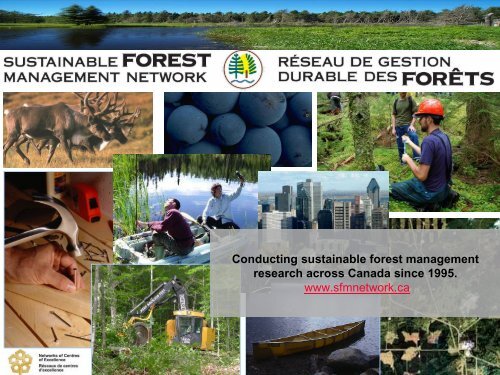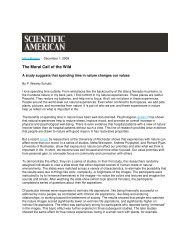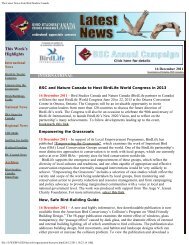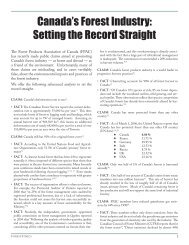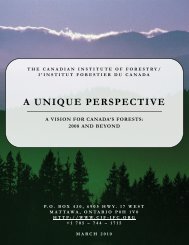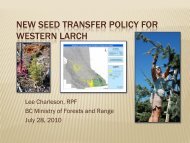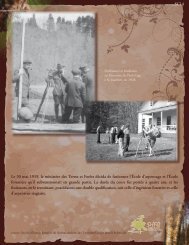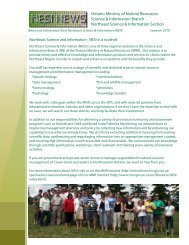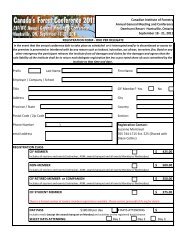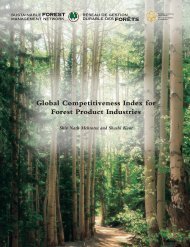What is harmonization - Canadian Institute of Forestry
What is harmonization - Canadian Institute of Forestry
What is harmonization - Canadian Institute of Forestry
- No tags were found...
You also want an ePaper? Increase the reach of your titles
YUMPU automatically turns print PDFs into web optimized ePapers that Google loves.
Conducting sustainable forest management<br />
research across Canada since 1995.<br />
www.sfmnetwork.ca
29 Funding Partners<br />
Treaty Eight<br />
First Nations<br />
Little Red River /<br />
Tallcree Nation<br />
Heart Lake First Nation<br />
Government <strong>of</strong> Alberta<br />
Government <strong>of</strong> B.C.<br />
Government <strong>of</strong> Manitoba<br />
Government <strong>of</strong> Ontario<br />
Gouvernement du Québec<br />
Government <strong>of</strong> Newfoundland<br />
and Labrador<br />
Yukon Government<br />
Mét<strong>is</strong> National council<br />
Manning Diversified<br />
Forest Products Ltd.<br />
Alberta-Pacific<br />
Forest Industries Inc.<br />
<strong>Canadian</strong> Forest<br />
Products Ltd.<br />
Tembec Inc.<br />
Moose Cree First Nation<br />
AbitibiBowater<br />
Kamloops Indian Band<br />
Tolko<br />
Industries Ltd.<br />
Da<strong>is</strong>howa-Marubeni<br />
International Ltd.<br />
Weyerhaeuser<br />
Canada<br />
Lou<strong>is</strong>iana-Pacific<br />
Canada Ltd.<br />
Partner-driven, university-based research<br />
J.D. Irving Ltd.<br />
<strong>Canadian</strong> Forest Service<br />
Environment Canada<br />
Parks Canada<br />
University <strong>of</strong> Alberta<br />
Ducks Unlimited Canada<br />
NCE Program
www.sfmnetwork.ca
ONE SIZE DOESN’T FIT ALL:<br />
FINDING WAYS TO HARMONIZE<br />
ABORIGINAL AND INDUSTRY<br />
INTERESTS IN FORESTS<br />
Chr<strong>is</strong> Hammond<br />
October 1, 2008<br />
Dr. Stephen Wyatt<br />
Ass<strong>is</strong>tant Pr<strong>of</strong>essor, Faculté de foresterie<br />
Université de Moncton, Edmundston, N.-B.
One Size Doesn’t Fit All:<br />
Finding ways to harmonize<br />
Aboriginal and industry<br />
interests in forests<br />
Stephen Wyatt,<br />
Faculté de foresterie<br />
Université de Moncton
Can we harmonize Aboriginal and<br />
industry interests in forestry <br />
Harmonization<br />
Co-management<br />
Treaties<br />
I’m more confused<br />
now than I was<br />
before ...<br />
Tenure<br />
Parks<br />
Public<br />
forests<br />
Joint<br />
ventures<br />
Consultation<br />
Community<br />
forests
Can we harmonize Aboriginal and<br />
industry interests in forestry <br />
Among SFMN priorities identified in 2006:<br />
Prepare State <strong>of</strong> Knowledge reports on ...<br />
3. Case studies <strong>of</strong> <strong>harmonization</strong> <strong>of</strong><br />
Aboriginal and forest industry interests<br />
4. Best practices for development and use <strong>of</strong><br />
traditional land use mapping studies in<br />
forestry
<strong>What</strong> do we already know about<br />
<strong>harmonization</strong> <br />
• Many different arrangements between<br />
First Nations and forestry companies<br />
across the country<br />
• Provinces have differing arrangements<br />
• Some projects succeed, others fail<br />
• Both conflicts and collaboration are<br />
common
<strong>What</strong> do we need to know about<br />
<strong>harmonization</strong> <br />
• <strong>What</strong> <strong>is</strong> “<strong>harmonization</strong>” - what about<br />
“consultation” and “collaboration” <br />
• Are different approaches to <strong>harmonization</strong><br />
the same <br />
• How do we choose which sort <strong>of</strong> project:<br />
co-management, tenure or a joint venture <br />
• <strong>What</strong> makes success or failure in a project <br />
• Is <strong>harmonization</strong> just about Aboriginal and<br />
industry interests
<strong>What</strong> do we already know about<br />
aboriginal land-use mapping <br />
• Much investment in traditional knowledge,<br />
land-use studies and maps, especially in<br />
the West<br />
• Studies and maps can help to protect<br />
sites and improve forest management<br />
• Difficulties and <strong>is</strong>sues around access to<br />
and use <strong>of</strong> th<strong>is</strong> information<br />
• A variety <strong>of</strong> “how to” guides ex<strong>is</strong>t
<strong>What</strong> do we need to know about<br />
aboriginal land-use mapping <br />
• Is traditional knowledge compatible with<br />
scientific management <strong>of</strong> forests <br />
• <strong>What</strong> are best practices for traditional<br />
knowledge, land use studies and mapping <br />
• How can studies and mapping make a<br />
difference
<strong>Forestry</strong> across management and<br />
knowledge systems<br />
Learn from projects across Canada<br />
Prepare two “State <strong>of</strong> Knowledge” reports<br />
• Case studies <strong>of</strong> <strong>harmonization</strong> <strong>of</strong> Aboriginal and<br />
forest industry interests<br />
• Best practices for development and use <strong>of</strong><br />
traditional land use mapping studies in forestry<br />
Build a database<br />
• Cases and examples <strong>of</strong> collaboration & mapping<br />
• Accessible to Aboriginal nations, industries and<br />
governments
Research team<br />
Stephen Wyatt Université de Moncton<br />
Ron Trosper<br />
University <strong>of</strong> BC<br />
David Natcher Univesity <strong>of</strong> Saskatchewan<br />
Solange Nadeau <strong>Canadian</strong> Forest Service<br />
Luc Bouthillier Université Laval<br />
Jean-Franço<strong>is</strong> Fortier Research ass<strong>is</strong>tant<br />
Garth Greskiw Research ass<strong>is</strong>tant<br />
Martin Hébert<br />
Peggy Smith<br />
Naomi Krogman<br />
Hugo Asselin<br />
Université Laval<br />
Lakehead University<br />
University <strong>of</strong> Alberta<br />
UQAT
Partners<br />
Aboriginal groups<br />
Treaty Eight First Nations<br />
Grand Council <strong>of</strong> the Cree<br />
First Nations <strong>of</strong> Québec and Labrador<br />
Sustainable Development <strong>Institute</strong><br />
Confederacy <strong>of</strong> Mainland Mi’kmaq<br />
Nicola Similkameen<br />
Forest industries<br />
Da<strong>is</strong>howa-Marubeni International<br />
Tolko Industries<br />
Ab<br />
Qc<br />
Qc<br />
N-S<br />
B-C<br />
Ab<br />
Ab<br />
Governments<br />
Alberta, Québec, Natural Resources Canada
<strong>What</strong> <strong>is</strong> <strong>harmonization</strong> <br />
Bringing different parts together to<br />
make a more pleasing whole<br />
In SFM, <strong>harmonization</strong> seems to mean<br />
considering Aboriginal and forest industry<br />
interests to:<br />
• meet the different needs <strong>of</strong> each<br />
• make forest management more sustainable<br />
• avoid conflicts
<strong>What</strong> <strong>is</strong> <strong>harmonization</strong> <br />
Québec - mesures d’<strong>harmonization</strong><br />
But ...<br />
A process for negotiating forestry practices<br />
between First Nations and companies<br />
‣ not all <strong>is</strong>sues are open for <strong>harmonization</strong><br />
‣ <strong>harmonization</strong> may mean assimilation<br />
It always seems to be us who have to<br />
harmonize to the industry - Atikamekw woman<br />
“Harmonization” <strong>is</strong> open to many different<br />
interpretations
<strong>What</strong> <strong>is</strong> <strong>harmonization</strong> <br />
Other terms may be more useful and clearer<br />
Consultation<br />
Negotiation<br />
Collaboration<br />
D<strong>is</strong>cussing <strong>is</strong>sues and learning<br />
from each other<br />
Debating and deciding upon a<br />
set <strong>of</strong> outcomes<br />
Working together towards a<br />
common or shared goals<br />
Reconciliation Overcoming differences or<br />
conflicts (long-term)
Are we achieving <strong>harmonization</strong> <br />
A wide variety <strong>of</strong> different approaches across<br />
the country<br />
Mesures d’harmon<strong>is</strong>ation<br />
Consultation processes<br />
Co-management<br />
Joint ventures & partnerships<br />
Revenue sharing<br />
Employment<br />
MoUs / agreements<br />
Certification<br />
Traditional knowledge<br />
Logging contracts<br />
Are these also means to <strong>harmonization</strong> <br />
Conflicts resolution<br />
Treaties<br />
Regulations<br />
Government policies
Are we achieving <strong>harmonization</strong> <br />
A database <strong>of</strong> more than 300 cases across<br />
Canada<br />
From the literature<br />
• Who <strong>is</strong> doing what <br />
• <strong>What</strong> are the results <br />
• <strong>What</strong> lessons can be learned <br />
From communities<br />
• <strong>What</strong> different approaches are being used <br />
• <strong>What</strong> <strong>is</strong> happening that <strong>is</strong> not in the literature
Data base <strong>of</strong> cases
Data base <strong>of</strong> cases
Are we achieving <strong>harmonization</strong>
Different ways <strong>of</strong> achieving<br />
<strong>harmonization</strong><br />
A classification <strong>of</strong> five main forms <strong>of</strong><br />
<strong>harmonization</strong> and collaboration<br />
Agreements & treaties<br />
Forestland mapping, planning and<br />
management<br />
Consultation processes<br />
Forest tenures<br />
Economic roles and partnerships<br />
with more than 40 different sub-types
Different goals for<br />
<strong>harmonization</strong><br />
Each party has their own goals &<br />
objectives, even within the same project<br />
Aboriginal<br />
• Exerc<strong>is</strong>ing<br />
rights<br />
• Access to land<br />
• Sharing in<br />
benefits<br />
• Applying &<br />
maintaining<br />
knowledge<br />
Industry<br />
• Access to<br />
timber<br />
• Compliance<br />
• Economic<br />
viability<br />
• Forest<br />
management<br />
Government<br />
• Addressing<br />
Aboriginal<br />
rights<br />
• Forest<br />
management<br />
• Economic<br />
development
Different sets <strong>of</strong> outcomes from<br />
<strong>harmonization</strong><br />
Social & cultural capital<br />
Sharing knowledge<br />
Respect for Aboriginal people<br />
Leadership<br />
Ecological<br />
capital<br />
Biodiversity<br />
Wildlife<br />
Forest health<br />
<strong>harmonization</strong><br />
project<br />
Economic<br />
capital<br />
Revenue<br />
Employment<br />
Training<br />
Institutions<br />
Building capacity<br />
Systems and processes
Critical steps in achieving<br />
<strong>harmonization</strong><br />
Supportive policy<br />
Time to<br />
implement<br />
Formal arrangements<br />
Information & research<br />
Legal<br />
frameworks<br />
Politics or business <br />
Catalyst<br />
Effective personnel<br />
Aboriginal, industry, government<br />
Financial<br />
support<br />
Work<br />
in progress<br />
Recogn<strong>is</strong>ed rights<br />
Good relations /<br />
confidence<br />
Access to forest<br />
Governance
A common path ...<br />
but not the only one<br />
Forestland<br />
management<br />
Work<br />
in progress<br />
Joint ventures<br />
Forest tenure<br />
arrangements<br />
Special<strong>is</strong>t capacity<br />
superv<strong>is</strong>ion, management<br />
Consultation<br />
on planning<br />
Sub-contracting<br />
Silviculture, harvesting, roading<br />
Landuse mapping
You want to harmonize your<br />
interests <br />
You have many choices !<br />
<strong>What</strong> are your goals -<br />
and those <strong>of</strong> your partners <br />
<strong>What</strong> outcomes are <strong>of</strong> most importance <br />
<strong>What</strong> are the limits <br />
capacity, policy, partners<br />
<strong>What</strong> forms <strong>of</strong> <strong>harmonization</strong> are<br />
appropriate <br />
<strong>What</strong> are the critical steps on your path
Different ways <strong>of</strong> achieving<br />
<strong>harmonization</strong><br />
A classification <strong>of</strong> five main forms <strong>of</strong><br />
<strong>harmonization</strong> and collaboration<br />
Agreements & treaties<br />
Forestland mapping, planning and<br />
management<br />
Consultation processes<br />
Forest tenures<br />
Economic roles and partnerships<br />
with more than 40 different sub-types
<strong>What</strong> <strong>is</strong> landuse mapping <br />
From “Chief Kerry’s Moose” by Terry Tobias
<strong>What</strong> <strong>is</strong> landuse mapping <br />
Mapping the ways in which Aboriginal groups<br />
use and occupy forestlands<br />
Traditional<br />
knowledge<br />
≠<br />
Landuse<br />
mapping<br />
Mapping landuse <strong>is</strong> not just making a map <strong>of</strong><br />
Aboriginal traditional knowledge
<strong>What</strong> <strong>is</strong> landuse mapping <br />
Land use and occupation represent Aboriginal<br />
relationships with the land<br />
Aboriginal<br />
knowledge<br />
Social<br />
structures<br />
Occupation,<br />
landuse<br />
Practices<br />
traditional &<br />
modern<br />
Customs,<br />
values<br />
responsibilities
<strong>What</strong> <strong>is</strong> landuse mapping <br />
Occupation <strong>is</strong> part <strong>of</strong> Aboriginal culture<br />
Aboriginal<br />
knowledge<br />
Social<br />
structures<br />
Occupation,<br />
landuse<br />
Practices<br />
traditional &<br />
modern<br />
Customs,<br />
rules<br />
responsibilities
Aboriginal knowledge & landuse<br />
and modern forest management <br />
Plenty <strong>of</strong> experience in<br />
‣ documenting Aboriginal knowledge<br />
‣ mapping landuse and occupation<br />
But there are <strong>of</strong>ten difficulties with :<br />
‣ applying th<strong>is</strong> in “forest management”<br />
‣ respecting Aboriginal values & rights<br />
‣ Aboriginal control <strong>of</strong> information<br />
Work<br />
in progress
Aboriginal landuse mapping<br />
Some <strong>of</strong> the barriers & difficulties<br />
Protecting Keeping<br />
confidential<br />
information<br />
information<br />
up-to-date<br />
Different<br />
meanings <strong>of</strong><br />
“knowledge”<br />
Landuse <strong>is</strong><br />
more than<br />
just sites<br />
Keeping<br />
information<br />
up-to-date<br />
Including<br />
social systems<br />
and values<br />
Work<br />
in progress
Aboriginal landuse mapping<br />
Some <strong>of</strong> the underlying <strong>is</strong>sues<br />
Protecting Keeping Aboriginal peoples<br />
confidential<br />
information want to be<br />
information up-to-date involved in<br />
dec<strong>is</strong>ions Landuse about <strong>is</strong><br />
management more than<br />
just sites<br />
Different<br />
meanings Respect <strong>of</strong><br />
“knowledge” for other<br />
living beings<br />
Keeping<br />
information<br />
up-to-date<br />
Nature<br />
can not be<br />
“managed”<br />
Human actions<br />
Including need to be<br />
social “managed” systems<br />
and values<br />
Work<br />
in progress
Different goals for<br />
Aboriginal landuse mapping<br />
Each party has their own goals &<br />
objectives, even within the same project<br />
Aboriginal<br />
• Maintaining knowledge<br />
• Role in dec<strong>is</strong>ion making<br />
• Protecting use <strong>of</strong> the<br />
land<br />
• Demonstrating<br />
ancestral rights<br />
• Protecting information<br />
Industry<br />
• Identifying sites to<br />
protect<br />
• Compliance<br />
• Access to information<br />
• Efficient planning<br />
Work<br />
in progress
Critical elements <strong>of</strong> “best<br />
practice” in landuse mapping<br />
Keeping information<br />
in its cultural context<br />
Ethics<br />
Elders and<br />
experts<br />
Sufficient resources<br />
People, money, equipment<br />
Time to<br />
implement<br />
Protecting<br />
confidentiality<br />
Who controls use<br />
<strong>of</strong> the information<br />
Work<br />
in progress
State <strong>of</strong> Knowledge<br />
Harmonization<br />
One size does not fit all<br />
Landuse mapping<br />
One option among many<br />
Parties need to<br />
‣ identify goals and outcomes,<br />
‣ recogn<strong>is</strong>e others interests<br />
‣ know conditions & limitations<br />
‣ choose appropriate options<br />
‣ build relationships<br />
Governments need to<br />
‣ make policy flexible<br />
‣ encourage processes, rather<br />
than provide solutions<br />
‣ Mapping <strong>is</strong> more than<br />
identifying sites in a GIS<br />
‣ Landuse includes values,<br />
institutions and practices<br />
‣ Parties have different goals<br />
for mapping projects<br />
Landuse implies:<br />
‣ respect for living beings<br />
‣ role in dec<strong>is</strong>ion making<br />
‣ managing people not nature
http://cif-ifc.org/en/e-lecture
Questions and comments please<br />
Harmonization<br />
One size does not fit all<br />
Landuse mapping<br />
One option among many<br />
Parties need to<br />
‣ identify goals and outcomes,<br />
‣ recogn<strong>is</strong>e others interests<br />
‣ know conditions & limitations<br />
‣ choose appropriate options<br />
‣ build relationships<br />
Governments need to<br />
‣ make policy flexible<br />
‣ encourage processes, rather<br />
than provide solutions<br />
‣ Mapping <strong>is</strong> more than<br />
identifying sites in a GIS<br />
‣ Landuse includes values,<br />
institutions and practices<br />
‣ Parties have different goals<br />
for mapping projects<br />
Landuse implies:<br />
‣ respect for living beings<br />
‣ role in dec<strong>is</strong>ion making<br />
‣ managing people not nature


